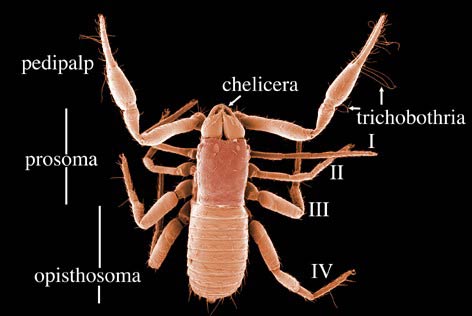- Pseudoscorpionida
Common names: pseudoscorpions
Probability of encounter: high
Quarantine importance: no known importance, but pseudoscorpions are predators capable of achieving high population densities and could be of conservation concern.
Similarity to mites: small size, chelicerae, and mite-like build. Pseudoscorpions range from 0.5 - 10 mm in length, tend to be dorsoventrally flattened, and are cryptic in coloration. Their scorpion-like pedipalps may be short and massive or elongated into slender forceps. Opisthosomas are clearly segmented.

Body tagmata: prosoma and opisthosoma broadly fused
Eyes: 0-2 pairs of lateral ocelli
Antennae: absent
Mouthparts: 2-segmented, pincer-like chelicerae with elaborate structures (serrula and flagellum) on movable digit and usually 1(rarely 3-4) submedian or subdistal hair; scorpion-like palps
Legs: 4 pairs; all legs used in walking
Distinguishing features: scorpion-like pedipalps, ventral embryo sac, serrula & flagellum on cheliceral digit; endocephalothracic silk system leading to pore on movable cheliceral digit